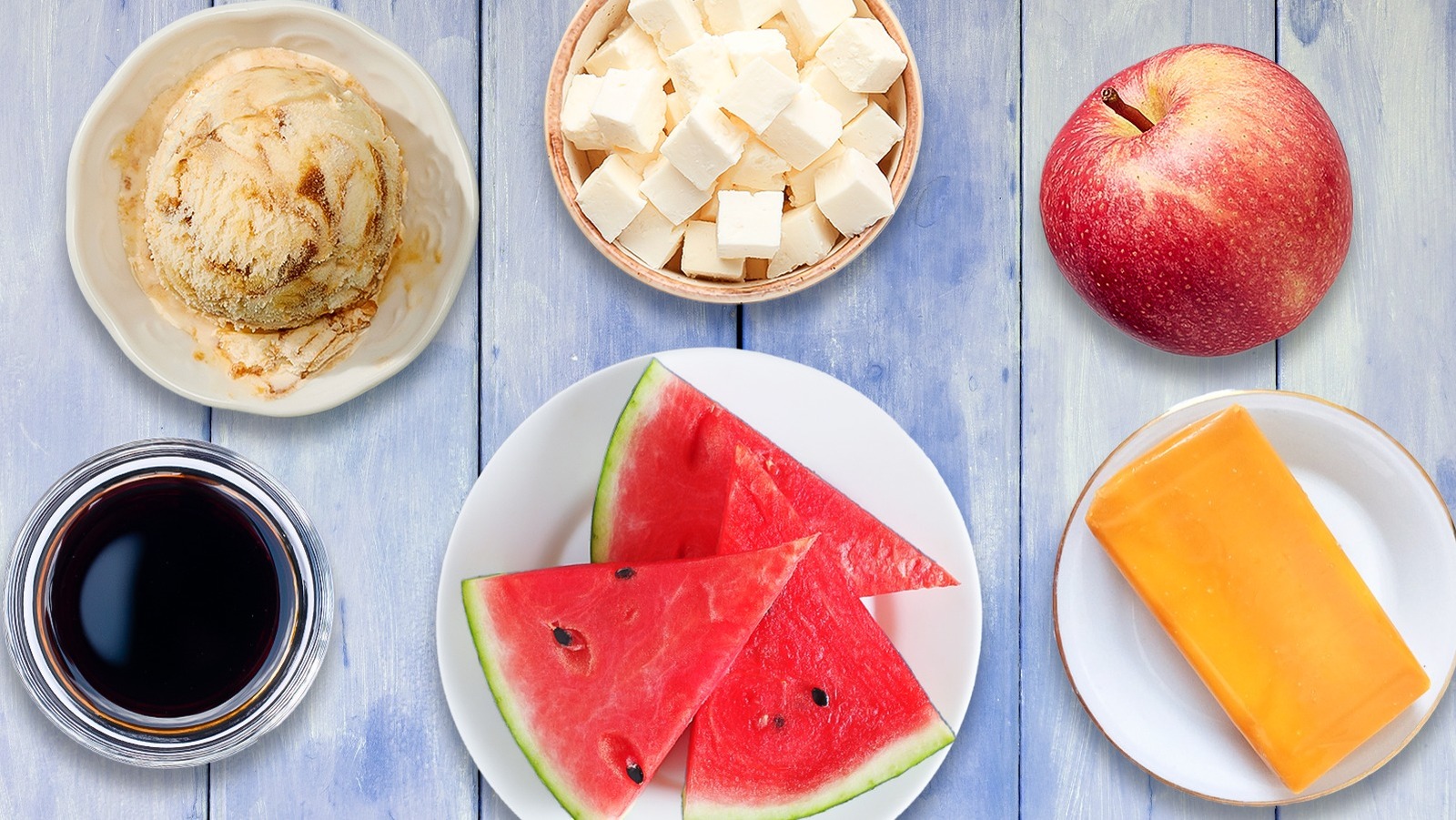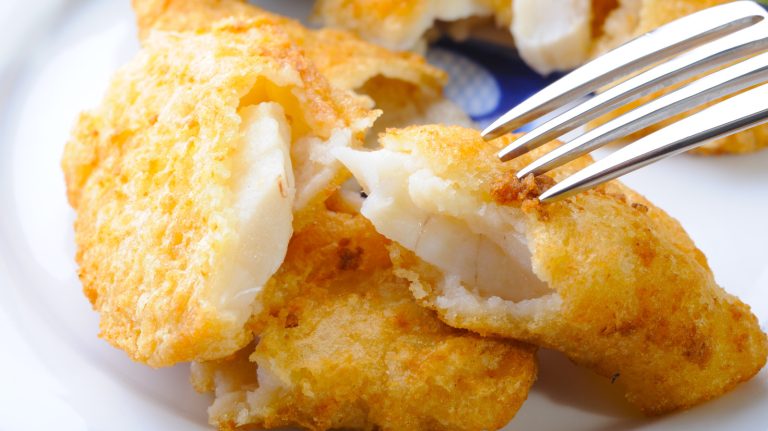We may receive a commission on purchases made from links.
Some ingredient pairings have stood the test of time, becoming iconic matches in the world of food. Take chocolate and mint, tomato and basil, and peanut butter and jelly, just to name a few; it’s hard to imagine a world without them. But if we were limited to only these classic gastronomic duos, our meals would get incredibly boring incredibly fast.
Remember being a kid, digging through the fridge to see what condiments you could add to your cereal or which yogurt flavor would go best on your ham sandwich? Well, those days didn’t end in adulthood for everyone. Some epicurean geniuses (or culinary heretics — that’s up to you) have dared to defy tradition with ingredient mash-ups that flip the cuisine landscape on its head.
In this list, we’ve spotlighted a few funky food fusions that unexpectedly create a flavor masterpiece. Some are spicy-sweet delights, others are umami bombs, and a few sound like the makings of a disturbing fever dream. But each pairing is a sensory extravaganza; they’ll have you heading to the kitchen to embark on a quest of concoctions the likes of which you haven’t known since childhood.
Chili crisp and ice cream
Chili crisp and ice cream may be one of the most egregious-sounding desserts you’ve ever heard of, but teens in Sichuan, China beg to differ. The unlikely pairing started in the Chinese cities of Chongqing and Chengdu in 2018, and — as is the case with anything obscure and interesting — as soon as teenagers discovered it, it went viral. Now, the world knows the glory of fiery ice cream, a creamy, spicy (admittedly, a little bit greasy) treat, and everyone has taken surprisingly well to it. McDonalds China even launched its own take on the glorious dessert, known as the Youpo Lazi Sundae (named for the Chinese chili oil-infused noodles), and fast food fans in China went goo-goo for youpo.
For those not in the loop, chili crisp is a condiment of dried pepper flakes floating in spicy oil. It goes best on rice and eggs, and now — apparently — ice cream. The contrast between sweet, chilly ice cream and crunchy, fiery chili crisp is a force to be reckoned with. The sugary, cooling abilities of ice cream guarantees that the chili oil is never too potent, but the heat still swoops in as an aftertaste. The crunchy peppers add texture to decadent soft serve (the ice cream of choice for pairing with chili crisp), while oil mixes with the cream for a luscious, palette-coating, sweet-and-spicy explosion.
Watermelon and feta
Watermelon and feta are essentially complete opposites. One’s a juicy embodiment of summer and the other is a dense, briny relic of the old world. But the watermelon-feta duo is a prime example of opposites attracting. Feta is a salty, crumbly cheese traditionally made from sheep’s milk that’s heavily associated with Greek cuisine. The cheese — with its dry, almost chalky texture and briny flavor — offers a superb contrast to sweet, moisture-riddled watermelon, which is made up of a whopping 92 percent water. The pair really doesn’t need any accompaniment to be refreshing and satisfying, though mint is a winner for adorning a salad or a cheese and fruit skewer.
Even though watermelon feels like an all-American fruit, it was actually first cultivated in ancient Egypt. Knowing this, watermelon with feta makes a lot more sense. Egypt and its Mediterranean neighbors likely fused cuisines, creating the combo that you’ve only ever seen once or twice as a salad at a hipster café. But in Mediterranean countries, watermelon with feta is as much a quotidian snack as peanut butter and jelly sandwiches are in the U.S.
Peanut butter and bacon
We’ve all undoubtedly seen bacon infused into peanut butter desserts at bakeries, but is the obscure combo any good? Elvis Presley would say so. The late, great musician was famous for his dietary habit, as well as pioneering rock and roll, and the food he was most heavily associated with was a deep-fried peanut butter, banana, and bacon sandwich. While Elvis’ cherished sandwich never really took off with the general public, peanut butter and bacon (usually sans banana) has found its way into baked goods, candy, and even burgers nationwide.
As a duo, peanut butter and bacon work wonders in both savory and sweet dishes. A peanut butter-drizzled donut topped with chunks of fresh, greasy bacon offers the perfect contrast of sweet and salty, with a nice mixture of textures to boot. The nutty spread and pork combo is even featured on burgers at experimental restaurants, or tossed into a bowl of ramen à la spicy peanut noodles, but with a crunchy upgrade. The pairing works well with chocolate thrown into the mix, too. Get your hands on a chocolate milkshake, swirl in some smooth peanut butter and bacon bits, and thank us later.
Caramel and fish sauce
In American cuisine, fish and caramel don’t belong in the same dish, full stop. But if you open your mind and look at the ingredients through the lens of Asian cuisine, where umami is king, you’ll start to understand what all the hullabaloo is about. Caramel infused with fish sauce is a ubiquitous sauce in Vietnam, where the salty-sweet mixture is used to poach fish, imbuing it with sweetness and doubling the fishy flavor. It’s also used to braise meat and veggies or wherever salted caramel might be applicable, like on chocolate, nuts, and ice cream.
To make caramel fish sauce, otherwise known as Vietnamese caramel, begin by melting down sugar the way you would for regular caramel. When it’s almost finished, slowly pour in a generous stream of fish sauce, tasting continuously until the caramel reaches your desired level of fishiness. Vegans and vegetarians can make the caramel with soy sauce instead, which will give the sugary sauce a similar salty, umami twist, but without the anchovy flavor.
Pineapple and mayo
To most people, juicy, tropical pineapple and eggy, fatty mayo creates an unapproachable marriage of flavors. However, to folks in the Southeastern U.S., pineapple and mayo is business as usual. The pineapple sandwich is a Southern staple that nearly every Alabama grandmother would whip up for all the grandkids as a summertime snack. The sandwiches have fallen out of favor in recent years, left behind in the realm of nostalgic foods that we miss dearly yet don’t go out of our way to make for some reason. But the simple, three-ingredient sandwich is worth a try, especially as a fruity, summer-ready contrast to a standard meat-laden sandwich.
To make this sweet Southern gem, simply smear white bread (yes, it must be white, don’t ask us why) with a liberal helping of mayo; aim for Duke’s, but any mayo will do, as long as it isn’t anti-mayo (otherwise known as Miracle Whip). Then top the slices with pineapple rings from a can. Fresh is acceptable, but juicier and sweeter canned pineapple is traditional. Something about the way the sugary fruit cuts through the decadent fat of the condiment is blissfully nostalgic, even to those not from the region where this strange but wonderful sandwich was born.
Pickle juice and whiskey
Whoever calls for pickleback shots first is instantly the coolest, most cultured drinker at the bar. For those not in the loop, a pickleback is a shot of whiskey chased by a shot of pickle juice. Although the combo sounds like a recipe for instant heartburn or an instant need to visit the bathroom, it’s actually one of the most satisfying ways to enjoy a shot of whiskey, especially when you’re not drinking the top shelf stuff. The salty, briny liquid masks the burn and harshness of well whiskey, without allowing it to creep back in once the saltiness has faded from the palate. Essentially, it makes cheap liquor taste smooth.
It feels like the pickleback has always been a thing, and every bar has kept a jar of pickle brine behind the counter for just this purpose since the dawn of time. But the elusive shot combo wasn’t invented until 2006, in the epicenter of trendy drink inventions: Brooklyn, New York. The pickleback came to be at the deceptively-named Bushwick Country Club, a dive bar in the eponymous neighborhood. The bar’s owner was asked by a regular for a shot of pickle juice with her Old Crow and was implored to drink along with her, and thus, the legendary chaser was born.
Dark chocolate and parmesan cheese
Dark chocolate is decadent and rich, with the perfect touch of sweetness to not mask the complexity of bittersweet flavors. Parmesan is salty, nutty, and pungent, with a deeply savory taste, making them a match made in cheesy dessert heaven. This isn’t one of those slightly obscure food pairings that pop up at trendy restaurants. This ingredient combo is actually proven by science to be a near-perfect match. Scientists working to discover new food pairings discovered that the juxtaposition between savory parmesan and the creamy nuances in dark chocolate mean that they’re destined to be together.
Dark chocolate accentuates flavors in parmesan cheese that normally go unnoticed in pasta or a creamy sauce. Fruity, zesty flavors pop against rich chocolate, essentially creating a brand new taste profile altogether. The question is, how do you go about combining them in a dish?
The simplest way to experiment with the two ingredients is by making an unconventional grilled cheese. This makes everything melty and delicious, while allowing the pair to shine without other ingredients clouding your judgement. Give it a go using Italian bread, and after tasting the sandwich on its own, add a light drizzle of sweet balsamic for added depth.
Eggs and grape jelly
Eggs and grape jelly are practically polar opposites on the food spectrum. One is buttery and savory, and the other is sharp and sugary. But their stark differences are what make them a dream team. Their textures are similar enough that the contrast in their tastes isn’t so striking that it becomes unpleasant. Both are soft, silky, and a little gelatinous, so they mesh well when smeared on toast. Plop a glob of grape jelly on top of some sunny side-up eggs and let the yolk swirl together with the jam, forcing sweetness and umami to join forces and create the funky flavor fusion that you didn’t know you needed.
Take the sweet-and-savory combo up a notch by smearing grape jelly on a classic breakfast sandwich with egg, meat, and cheese. New Jerseyans might be perturbed, but they have to admit that the saltiness of a typical breakfast sandwich can be a little bit much, so a little sweet reprieve is sometimes welcome. You can even go the extra mile and squirt a little ketchup on it, too — we dare you.
Peanuts and Coca-Cola
The South is a haven for odd food combinations, so it should come as no surprise that yet another Southern staple found its way onto this list. Peanuts in Coca-Cola sounds strange and, frankly, a little bit gross, but since sweet and salty is the ultimate flavor pairing, why wouldn’t it work?
The timeless, Southern tradition of peanuts in Coca-Cola is thought to have started in the 1920s, when shelled peanuts first became a common snack. One possible reason behind the practice may have been to maintain cleanliness. On the job, there weren’t many opportunities for handwashing, which made snacking on peanuts a dangerous game. So, working folks plopped the nuts in a bottle of Coke, and enjoyed the sweet with the salty in one go, while keeping dirty hands off of food.
Since putting peanuts directly into a bottle of Coca-Cola can be a choking hazard for some people, particularly the elderly and children, it’s worth noting that the combo can be thoroughly enjoyed without physically combining them. Simply eat a few peanuts and wash them down with a swig of Coke to get the full nutty, fizzy experience.
Blueberry and coffee
Everyone knows that rich flavors like vanilla, chocolate, and caramel are delicious in coffee, but blueberry is a coffee flavor in its own echelon. On paper, it doesn’t seem particularly appealing; after all, fruit flavors are usually among the most unappealing ingredients you should really stop adding to coffee. But blueberry isn’t like other fruits. It isn’t intensely tart like other berries, and its mellow, sweet flavor is a stark contrast against coffee’s bitter bite. In fact, some Ethiopian coffees are tirelessly pursued for their natural, blueberry-like notes, so why not recreate those flavors with your own java?
To add blueberry to coffee, try this blueberry syrup from DaVinci or make your own for a fresh taste that’s sweetened to your preference. Simmer some fresh or frozen blueberries with sugar for about 10 minutes, then add a touch of vanilla and lemon juice, and strain the liquid from the berries. Fresh, sweet blueberry syrup is delicious in iced coffee come summer, when caramel or chocolate can bog you down in the heat. Or, if you don’t want to buy syrup or go through the hassle of making your own, try brewing ground beans with loose blueberry tea leaves. The tea adds vibrant blueberry flavor and sometimes floral notes that wake up the subtle flowery, fruity nuances in a cup of joe.
Cantaloupe and prosciutto
Fruit and meat aren’t always strangers, so prosciutto and cantaloupe may seem like an odd combo, especially if you’re not from Italy. Since ancient times, cured meats and sweet fruits have been paired in Italy for perceived health benefits (and because it’s a delicious match-up). Prosciutto and cantaloupe, however, weren’t around in the days of old. The pair — known as prosciutto e melone — didn’t pop up until about 1890, when it was recorded in one of Pellegrino Artusi’s cookbooks. Although the father of modern Italian gastronomy coined the duo in the late 19th century, it didn’t become commonplace until the 1960s, when fruit was winding up in every dish, be it dinner or dessert.
Cantaloupe and prosciutto bring out the best in each other. Salty, silky prosciutto — Italian thin-sliced cured ham — is so delicate that it practically melts in your mouth, leaving behind a rich, fatty taste. The richness of the cured meat accentuates mildly sweet cantaloupe, amplifying its famous honeyed flavor. Serve it on your next charcuterie for a bold, Mediterranean vibe, or simply wrap slices of melon in prosciutto and enjoy it as a snack or fresh appetizer. This is a summer dish that needs absolutely nothing else to be perfetto.
Soy sauce and ice cream
Ice cream drenched in soy sauce is undeniably pushing the boundaries on the classic sweet-and-salty combo. Ice cream is ultra creamy and decadent, while soy sauce is the star of umami, with bold saltiness and a mellow earthy flavor that’s delicious on fish and veggies. But there’s something to be said for the highly unlikely pairing, which isn’t for everyone but can certainly appeal to salty-sweet lovers. Just think of it like extreme salted caramel ice cream.
The flavors in umami soy sauce and vanilla ice cream don’t instantly mesh well together; it takes some getting used to. At first, saltiness and creamy sweetness are fighting each other for dominance over your taste buds. But once you submit and let them fight it out, they eventually merge together to create a weird yet harmonious sensation. Soy sauce enhances the herbaceousness of vanilla, while the cool ice cream makes the salt in soy sauce less overwhelming. To help the pair blend together seamlessly, add some candied nuts for more sugar and a nice crunch that compliments the earthiness in the condiment.
Black pepper and pumpkin
Pumpkin spice is probably the most illustrious spice blend in the entire spice blend repertoire. Come fall, it finds its way into everything, and it’s hard to imagine eating anything pumpkin-based without it. But there’s one spice ideal for pumpkin that often gets cast to the side in favor of cinnamon, nutmeg, and cloves: black pepper. Black pepper and pumpkin produce a harmonious marriage of earthy, sweet, and spicy that makes fall and winter recipes all the more comforting.
Black pepper brings out pumpkin’s natural flavor more so than the tried and true pumpkin spice blend alone, which does more to add sweet, warm notes to the fall veggie. To try out the unlikely duo, add a generous sprinkle of black pepper into pumpkin pie filling and watch the dessert come to life. A touch of warming heat and intense earthiness makes pumpkin sweeter and brighter, whether you’re working with canned or fresh gourd. Try a latte with just pumpkin purée and black pepper, foregoing the sweet spices, and see for yourself how much the pepper really takes pumpkin to the next level.
Apple and cheddar
Apples and cheddar cheese are both classic American ingredients, and eating them together is an all-American experience. The pair aren’t strangers to a fruit and cheese board, and are admittedly not that odd of a combo. A piece of Gala apple with a particularly sharp slice of the “good” cheese is delicious enough to be a meal on its own. But things start to get contentious when it comes to pie. A slice of apple pie with a hunk of melty cheddar on top is one of the most iconic American dishes, but a hotly debated one. The pairing is normally associated with the state of Vermont, where cheese and apples are a source of pride.
Some folks scoff at extra-sweet, caramelized apples, cinnamon, and flakey pastry dough coupled with the salty tang of cheddar. But we’re not here to pick sides — just to state facts. Savory cheese with a sharp bite and the warming spices on sweet, tart fruit in apple pie are pure opposites, and we all know that opposites attract. Each ingredient complements the other, adding depth of flavor to the entire dish. Just don’t add ice cream into the mix — that’s taking it too far.





